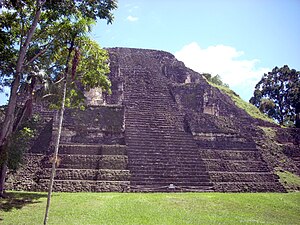 The Lost World Pyramid (Structure 5C-54) dominates the complex. View of the restored west face. | |
| Location | Flores |
|---|---|
| Region | Petén Department, |
| Coordinates | 17°13′12.17″N 89°37′40.56″W / 17.2200472°N 89.6279333°W |
| History | |
| Founded | c. 700 BC |
| Abandoned | c. AD 900 |
| Periods | Preclassic–Terminal Classic |
| Cultures | Maya civilization |
| Site notes | |
| Excavation dates | 1979–1985 |
| Archaeologists | William R. Coe; Juan Pedro Laporte IDAEH |
| Architecture | |
| Architectural styles | Talud-tablero, Preclassic & Classic Maya |
| Architectural details | Number of monuments: 1 Number of temples: 5+ |
| Restored by Proyecto Nacional Tikal (1979–1985) Responsible body: IDAEH | |
The Mundo Perdido (Spanish for "Lost World") is the largest ceremonial complex dating from the Preclassic period at the ancient Maya city of Tikal, in the Petén Department of northern Guatemala.[1] The complex was organised as a large E-Group astronomical complex consisting of a pyramid aligned with a platform to the east that supported three temples.[2] The Mundo Perdido complex was rebuilt many times over the course of its history. By AD 250–300 its architectural style was influenced by the great metropolis of Teotihuacan in the Valley of Mexico, including the use of the talud-tablero form.[3] During the Early Classic period (c. 250–600) the Mundo Perdido became one of the twin foci of the city, the other being the North Acropolis.[4] From AD 250 to 378 it may have served as the royal necropolis.[4] The Mundo Perdido complex was given its name by the archaeologists of the University of Pennsylvania.[5]
The large plaza centred upon the Lost World Pyramid (5C-54) and the ceremonial platform to the west (5C-53) is divided into two clearly demarcated areas referred to as the High Plaza and the Low Plaza. The High Plaza is the area around the Lost World Pyramid. It is closed on the south side by Structures 6C-24 and 6C-25. A range of eight adjoining structures divide the High Plaza from the Plaza of the Seven Temples to the east. On the north side, the Plaza is principally delimited by Structures 5D-77, 5D-45, 5D-46, together with some smaller structures. The Low Plaza lies to the west of the Lost World Pyramid, centred upon Structure 5C-53, a low platform. The Low Plaza is closed on its north side by the Talud-Tablero Temple (5C-49), which is the second largest structure in the whole complex.[6] The complex has a surface area of approximately 60,000 square metres (650,000 sq ft).
Guatemalan archaeologists have made major discoveries in the Mundo Perdido since the 1970s.[7] The National Tikal Project (Proyecto Nacional Tikal) investigated the Mundo Perdido from 1979 until 1985, and partially restored the principal structures of the complex.[8] The Mundo Perdido was the first architectural complex to be built at Tikal in the Preclassic period and the last to be abandoned during the Terminal Classic.
- ^ Martin and Grube 2000, p.28.
- ^ Martin and Grube 2000, p.28. Estrada Belli 2011, p.60.
- ^ Martin and Grube 2000, p.29. Sharer and Traxler 2006, p.321.
- ^ a b Martin and Grube 2000, p.29.
- ^ Cite error: The named reference
Coe6788p90was invoked but never defined (see the help page). - ^ Coe 1967, 1988, pp.90–91.
- ^ Cite error: The named reference
Drew99p186was invoked but never defined (see the help page). - ^ Coe 1967, 1988, p.92.

